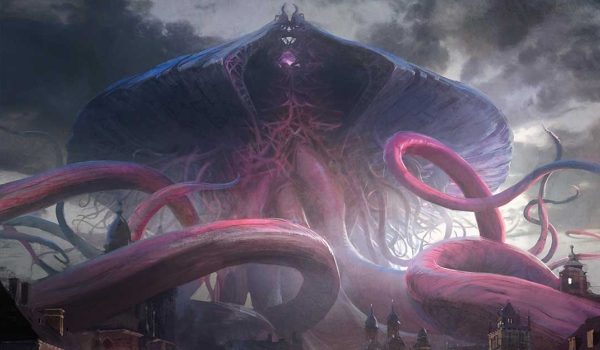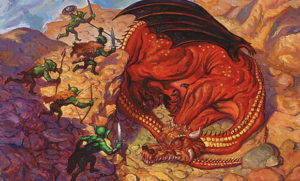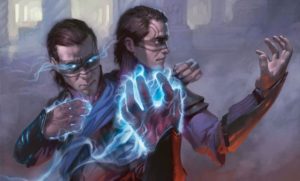Cube Card Spotlight: Emrakul, the Promised End

Sadly, I can’t advise you to get your new Emrakul while they are cheap. Magic’s new Iron Lady didn’t stay under the radar long. I don’t see the price going down on Emrakul in the same way that it does with a lot of standard mythics either. The reason being that Emrakul, the Promised End is playable in a lot of formats beyond standard. The power level of the card is just off the charts for something you can reasonably play in the 5-7 mana range. I expect it to see at least some modern play, eternal formats are a possibility for her and she is of course already a cube and EDH staple.
When I first reviewed the card I described her as being the closest a good Magic card has ever come to having the text “You win the game.” on it. Her original form may disagree as it is absolutely the more powerful card. There are two differences between the Promised End and the Aeons Torn that make the former better at winning the game despite packing less total power. Firstly, you have to cast both for them to really have that game ending power as much of it comes from the on cast trigger, the body itself is answerable. Casting a 15 mana card is just not something you can reliably do at all, even in cube, while playing something for 5-8 mana is very feasible.
The second difference is the manner in which they pressure your opponent. Aeons Torn gives the best body in the game plus a Time Walk effect. The Time Walk is good value and makes the body much more likely to cause game ending damage but if the body is dealt with, the Time Walk is pretty far from game ending. You only really need to have the one appropriate answer to a hard cast Aeons Torn and you are OK. With the Promised End the body is no where near the power level of Aeons Torn, however, it will still usually kill in one or two hits just the same and as such is still very much something that needs to be dealt with. The on cast trigger for the Promised End is a significant threat it its own right and that is why it is a more consistent finisher than Aeons Torn, a card that can be shut down by a Karakas or a Gideon’s Law Keeper! While you may get the same total amount of extra turns with both the triggers from the two Emrakul’s, the ability to use your opponents stuff against them is significantly more brutal and poses an actual threat distinct from the body.
Combining these two attack angles of having a massive flying, trampling dork with some removal protection and having a Mind Slaver like effect from the same card is really really hard to beat. If the Mind Slaver does nothing then the 13/13 is going to get the job done. If they have a hand full of gas that might stop the 13/13 then the Mind Slaver effect is going to devastate them. The odds on you having the specific set of stuff that allows you to deal with a 13/13 flying, trampler before it kills you without just losing to a Mind Slaver are incredibly low. I don’t need to persuade people the card is good as this has been done already at PT Eldritch Moon. What I can do is give some pointers as to how you can aim to use it in the cube.
Unlike most other top end creatures in the cube Emrakul, the Promised End is not one that benefits much at all from being cheated into play. Sure, a 13/13 flying trample with protection from instants is decent enough but there are things that are more reliable, safer, more disruptive or that offer more value than the Promised End if used with the vast array of cards like Oath of Druids, Sneak Attack, Reanimate, Show and Tell etc. The only cheat cards that cast her are Shelldock Isle which is certainly a good use for her but not really an archetype in itself and Channel. Basically, if you want to include the Promised Endm you want to plan to cast her. If your deck is focused on cheating out big dorks Emrakul, the Promised End is not a great inclusion. You are probably going to get more out of one of the Titan Cycle.
I have built decks that rush to maximise the cost reduction on Emrakul and then cast her for five or six, ideally on turn four or five. This is achievable although it is more consistently something you get done by turn seven. The problem with such strategies is that you don’t get all that much useful stuff done before then and are usually going to die before you cast her. Having a good spread of all the different card types is hard to then make a cohesive deck with.
The places where Emrakul, the Promised End performs best are control decks and ramp decks. Some midrange decks with ramp, control and some card filter elements also provide a decent home for her. The logic is fairly simple for the control decks, if you can make the game go on a bit longer then you will naturally have more of a cost reduction going on for Emrakul. Likely those decks will be mostly land followed by instants with a selection of creatures and sorceries. There will probably be a couple of planeswalkers and perhaps the odd artifact or enchantment. You will never get the full eight reduction in such decks and can probably only realistically expect to cast it on curve with a reduction of four or five but for a card that has really got a shot at winning the game in short order, that is more than reasonable. It sits in the same sort of place as an Aetherling or an Entreat the Angels; a really good top end finisher that is a bit awkward to have too many of simply because of their lack of early use.
Where Emrakul shines over Aetherling as a finisher is that it has more potential to recover you from far behind and provides more inbuilt safety. You can tap out to cast Emrakul and not have it be a disaster. You can use her to prevent more combat damage and any reach they may be holding in hand. You will also find that in games where you fall behind on lands yet still go long that she’ll be far more powerful. It might be turn twelve and you might only have reached six or seven mana, at which point an Aetherling would be quite risky however your Emrakul is quite the swing! She is much more proactively devastating against spell heavy decks and combo decks than any other control finisher and doesn’t require counter backup to be played either. Control decks are threat light and so you want your threats to get the job done when it is their time. Emrakul, the Promised End sits alongside the best alternatives on offer and provides some unique attributes.
For ramp decks, Emrakul sits more in the slots of Ugin and Karn in that her strength is disruption on a threat. Green struggles with removal and Ugin and Karn bring a lot of safety to the table by being able to kill stuff. Emrakul doesn’t directly kill stuff although she can force chump attacks to gain this effect. What she does do is cover another area green is lacking in and that is the ability to attack spells in hand. Ramp decks are liable to have to pay a little more for Emrakul than the control lists simply because they have less ways to put things in the bin and a more polar range of card types. Despite this, the ramp decks can expect to cast Emrakul significantly quicker. Green ramp in particular has a way of getting out of hand. Once you get to five or so you seem to effectively have infinite. A turn four Emrakul for ten isn’t unrealistic. A turn five or six for eight or nine will be common.
While a bit more awkward than the big planeswalkers to build with, Emrakul takes far less time to win a game. The planeswalkers are slow for such expensive cards and typically rely on you having other things to compliment them as you take control of the game. Emrakul comes down, devastates their hand and plan and then kills them very quickly all on her own. She is more like casting Karn Liberated followed by a Craterhoof Behemoth and as such is like having all your top end desires in one card.
Artifact ramp decks can play her too but she is a little riskier there as they have less control over what is in the graveyard, typically an even more polar range of cards while not having the same ramping momentum green decks have. Artifact decks will often ramp to a decent amount and then just sit there for the rest of the game on that mana or there about. I would be more inclined to stick with slightly cheaper cards and ones that work with artifact synergy stuff like Metalworker and Tinker than warp my artifact ramp deck to clumsily accommodate the Promised End.
One of the great things about Emrakul, the Promised End is that she is playable in quite a wide selection of decks, however, in each of them she needs to be given some consideration in deck construction. You can’t just ram her in and always expect her to be good just because she is playable in that archetype. Care in balancing your card types and your filter effects will do wonders to improve the power level of the latest among the Eldrazi top dogs.








